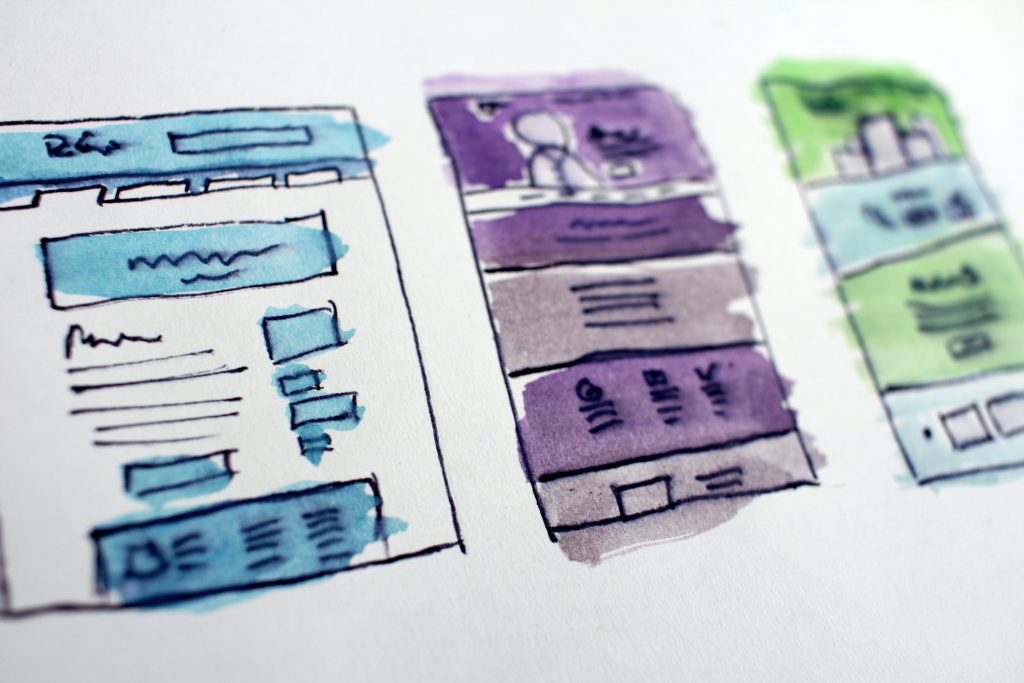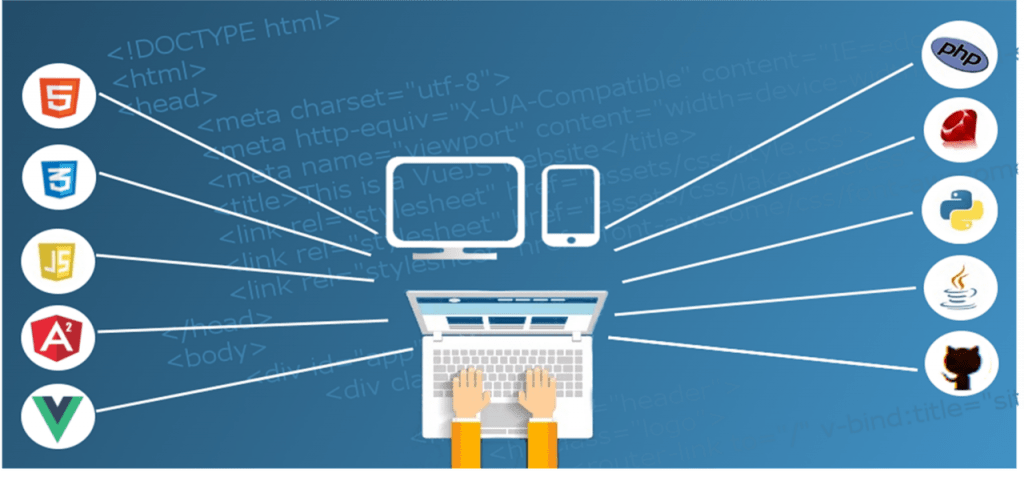Are you looking for small business website design tips? This blog post is full of small business website design ideas and advice. You’ll learn everything you need to get started with your new website design.
Creating a small business website can be overwhelming. But with these 11 tips, you can create a website that will help promote your small business and its products or services.

In this article, we will cover how to:
- Choose the Right Domain Name
- Choose the Right Platform
- Choose the Right Hosting Service
- Make Your Site Mobile Responsive
- Make it Simple to Find Information
- Keep Your Pages Clutter-free
- Have A Clear Call to Action
- Optimize Your Content for Search Engines (SEO)
- Create Engaging Content
- Install Analytics Tools (And Use Them)
- Perform Regular Maintenance
Choose the Right Domain Name
Choosing the right domain name is one of the most important decisions you’ll make for your small business. A domain name can make or break your small business website. Think about an acronym for your small business and try to find a domain with that word in it. For instance, if you have a small construction company with the name “Building Bob’s Construction Co.,” then you might want to use the domain buildingbobs.com for your small business website.
Domain names can be purchased through a domain name registrar or your web hosting company. Most small business website design platforms offer a free domain when you set up your site with them. Be sure to do your research and find the best deal on a domain name before you purchase it.
Choose the Right Website Platform

Once you’ve decided on a domain name, it’s time to choose the web design platform that is right for your small business. There are many platforms out there like WordPress, Wix, and Squarespace. Deciding which one is best can be overwhelming. (We personally love and recommend WordPress for how easy it is!)
There are several things to consider when choosing a small business web design platform:
Your goals – Do you want to create a website that sells products or services, provides information about your company, or is a combination of both?
Your budget – How much are you willing to spend on your small business website design?
The level of technical expertise you have – Some web design platforms are easier to use than others. If you’re not very technically savvy, you’ll want to choose a platform that is user-friendly.
Your time constraints – How much time are you willing to put into maintaining your small business website?
Once you have determined what you want your small business website to do, it will be easier to decide on the right platform.
There are three main types of small business website design platforms:
Do-It-Yourself (DIY) Platforms – These platforms are typically the least expensive and allow you to create a website yourself without any coding or programming knowledge. However, most DIY platforms do not offer many customization options and you will be limited in what you can do with your site.
Website Builder Platforms – These platforms are a step up from DIY platforms. They allow you to create a website with more customization options, but you still don’t need any coding or programming knowledge.
Coding/Programming Platforms – If you want complete control over your small business website design and have the technical expertise to use them.
Bonus! – Get the best of both worlds by hiring a developer to do the heavy lifting. You can give them specific instructions on what you want and they will create the perfect starting point for your small business website. It costs a bit more up front, but allows you to stay focused on your business.
Choose the Right Hosting Service
After you’ve chosen the small business website design platform that works best for your small business, you need to find a hosting service. Hosting services provide space on their server where your small business website will be stored and delivered through the internet to anyone who wants to view it.
Just like there are three types of small business website platforms, there are three general types of hosting services:
Shared – This is the least expensive option and usually works best for small businesses. When you use a shared service, your small business website will be stored on the same server as several other small business websites. That means that if one of those sites gets a lot of visitors at once, it could slow down your small business website.
Virtual Private Server (VPS) – A VPS is a step up from a shared hosting service. Your small business website will be stored on its own server and will not be affected by the traffic on other sites. This option is more expensive than shared hosting, but it can be worth it if you’re expecting a lot of traffic.
Dedicated Server – A dedicated server is the most expensive hosting option and is best for small businesses that expect a high amount of traffic. With this service, your small business website will be the only site hosted on the server.
What We Recommend
If these options don’t make much sense, we recommend a fourth option – WordPress Managed Hosting. With this service, you work with a hosting company that will take care of all the technical aspects of website hosting for you. This is a fantastic option if you don’t have the time or expertise to manage your own small business website.
Make Your Site Mobile Responsive

Now that more and more people are viewing websites on their mobile devices, it’s important to make sure your small business website is responsive as part of your design process. This means that the site will automatically adjust to fit the screen of whatever device it’s being viewed on – whether it’s a phone, tablet, or computer.
Approximately half of webs traffic worldwide is on a mobile device.
You’ll be making a BIG mistake if you don’t consider mobile, because being unresponsive means you’re losing out on potential customers who want to view the content of your small business website but can’t see it properly when they visit from their phone or tablet.
We recommend using a responsive design template (or hiring your development out) if you’re not comfortable with coding or programming. This is an inexpensive option that will ensure your small business website looks great no matter what device it’s being viewed on.
Make it Easy to Find Information on Your Business
When people visit your small business website, you want them to be able to find the information they’re looking for quickly and easily. This means using clear and concise headings and making sure your main navigation is easy to spot. Some quick tips are to:
- Use a clear hero image and headline at the top of the page.
- Display only relevant content is easy to see places.
- Use padding to create space between different design elements.
- Follow a “standard” web layout with a regular menu (in the top bar
You should also use a search bar if your small business website has a lot of content. That way, people can search for the information they need without having to scroll through every page.
Keep Your Pages Clutter-free

One of the biggest mistakes small business owners make with their website is filling it up with too much information. Not only does this make the site look cluttered, but it also makes it difficult for people to find what they’re looking for.
When you’re designing your small business website, try to limit the number of pages to only the most important ones. And be sure to use clear and concise headings so people know what each page is about without having to read the entire thing.
Have A Clear Call to Action

When people visit your small business website, they should have a clear idea of what you want them to do. This could be calling you on the phone, visiting your location, or sending you an email. This means using a call to action – whether it’s clicking on a button or filling out a form – that will tell visitors exactly what you want from them.
If your small business doesn’t have an e-commerce component (selling a product online), consider using a call to action that will encourage people to contact you or visit your physical location. This works well for small businesses in service industries or even local retailers.
Optimize Your Content for Search Engines (SEO)

Search engine optimization (SEO) is a key part of small business website design. In fact, you can’t have one without the other. We could write full-length articles just to try and cover how broad the SEO topic is (let us know if you’d like us to).
The heart of SEO means using keywords throughout your small business website content so that people looking for your business, services, or products will be able to find them in search engines like Google and Bing.
There are other advanced techniques, like adding meta descriptions and titles to your pages, to help improve your small business website’s ranking in search engine results. While these can be helpful, it’s important to focus on writing for your small business website visitors first and search engines second.
SEO is a very complicated topic that we could go into great depth about but didn’t want to overwhelm you with information! If you aren’t sure how to make your small business website SEO-friendly or if you’d like to hire a small business website designer, we can help.
Create Engaging Content
We’ve talked a lot about small business website content and how it should be useful, engaging, and easy to find. This is another important part of small business website design that many small businesses miss out on – their small business website isn’t interesting!
You might think you don’t need to spend time writing entertaining or creative small business website content. But small business websites that are boring do nothing but waste your time and visitors’ time, too!
You can make up for this by making sure you use interesting images and videos on your small business website. You can also write blog posts that are interesting to read and share on social media.
Make sure you’re putting out interesting content! It’s one of the most important aspects of small business website design (and marketing in general).
Install Analytics Tools (And Use Them)

If you want to track the small business website performance of your site, you’ll need a tool to gather data. There are quite a few free analytics tools out there that small businesses can use for their small business websites.
Install analytics tools on your small business website to track how it’s performing. You can use this data to improve your site over time!
Some great analytics tools we recommend are:
Google Analytics
Google Analytics is the classic example, as Google offers small businesses an easy way to see how people are using their small business website. This data can help small businesses understand what pages people are visiting, how long they stay on each page, and where they’re coming from (which search engines, social media networks, etc.).
Hotjar
Hotjar is a newer tool that small businesses can use to see how people are using their small business websites. It records user sessions so small businesses can watch people interact with their site. This is great for understanding how well your call to action buttons or forms are working, as well as where users are getting lost on your small business website.
Mixpanel
Mixpanel is another small business website analytics tool that’s great for tracking customer behaviour. It can allow small businesses to set up goals (like viewing a certain page) and then track which customers are achieving those goals, as well as how they got there.
Crazy Egg
Crazy Egg is an advanced small business website analytics tool that helps small businesses see how people are interacting with their small business websites. It can show you which elements of your site users are clicking on (or hovering over), where they’re scrolling down to, and more!
Install these small business website tools today so you know exactly what’s going on with your website. This data will give you great insight into what small changes to make that can really boost small business website performance!
The key to using these tools is to not just “set it and forget it”. Scheduling regular reviews of your website’s analytics can help you identify bugs, find opportunities, and increase the chance that a website visitor will convert (contact you or buy a product).
Perform Regular Maintenance

Finally, small business website design is about small changes. As small businesses grow and their small business websites become more complex, they may find that there are parts of their websites that aren’t performing as well as others.
This doesn’t necessarily mean it’s time for a full redesign but instead can be opportunities to make small changes like updating images, fixing small errors on pages, or changing the way a form works.
Performing regular maintenance on your small business website is key to keeping it running smoothly – and ensuring that your small business website design is always up-to-date!
In Conclusion
You’ve got the domain name, you’ve chosen a platform and hosting service. Now what? It is time to start building your small business website!
Building a small business website can seem daunting, but with the right tools and advice, it can be easy! In this article, we’ve outlined 11 tips to help small businesses build their small business website. Follow these tips and you’ll be on your way to having an online presence that helps your small business grow.
Need Some Help?
If you need some help getting started, our team of small business website design experts are here to help. Contact us today for a free consultation!